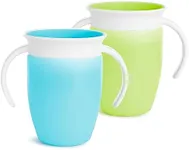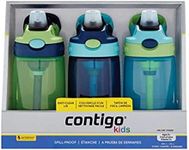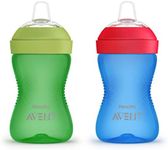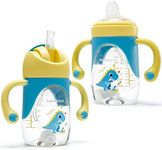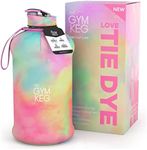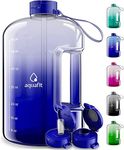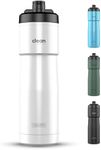Buying Guide for the Best Toddler Water Bottles
Choosing the right water bottle for your toddler is important for both their health and your convenience. The ideal bottle should be safe, easy for little hands to use, and simple to clean. Since toddlers are still developing their coordination, the bottle should also be spill-resistant and durable enough to withstand drops and rough handling. By understanding the key features, you can select a bottle that matches your child’s needs and your lifestyle.MaterialThe material of a toddler water bottle affects its safety, weight, and durability. Common materials include plastic, stainless steel, and glass. Plastic bottles are lightweight and often less expensive, but you should look for BPA-free options to ensure safety. Stainless steel bottles are durable and can keep drinks cool, but they are heavier and may dent if dropped. Glass bottles are the safest in terms of chemicals but are heavier and can break more easily, though many come with protective sleeves. Consider your child’s age, strength, and how the bottle will be used when choosing the material.
Spout TypeThe spout is the part your child drinks from, and it can be a straw, sippy spout, or open top. Sippy spouts are good for transitioning from bottles and are usually spill-resistant. Straw spouts encourage sipping and can be easier for some toddlers to use, but they may be harder to clean. Open tops are more like regular cups and help with development, but they are not spill-proof. Choose a spout type based on your child’s drinking skills and whether you need something spill-resistant for travel or outings.
CapacityCapacity refers to how much liquid the bottle holds, usually measured in ounces or milliliters. Smaller bottles (around 8-10 ounces) are lighter and easier for young toddlers to handle, while larger bottles (12-16 ounces) hold more water but can be heavier and bulkier. Think about how long your child will be away from home and how much they typically drink to decide on the right size.
Ease of CleaningA bottle that is easy to clean helps prevent mold and bacteria buildup. Bottles with fewer parts and wide openings are generally easier to wash by hand or in the dishwasher. Some bottles have removable straws or spouts, which can be helpful but may require extra attention to clean thoroughly. If you want to save time and ensure hygiene, look for bottles that are dishwasher-safe and have simple designs.
Leak-Proof DesignA leak-proof bottle prevents spills in bags, strollers, or car seats. Some bottles have special valves or locking mechanisms to stop leaks, while others rely on tight-fitting lids. However, more complex leak-proof systems can be harder to clean. If your toddler is prone to dropping or shaking their bottle, or if you plan to carry it in a bag, a reliable leak-proof design is essential.
Grip and SizeThe shape and size of the bottle should fit comfortably in your toddler’s hands. Some bottles have handles or textured grips to make holding easier, especially for younger children. If your child is just learning to drink independently, look for bottles with ergonomic designs or handles. As your child grows and their grip improves, you may prefer a more streamlined bottle.
InsulationInsulated bottles keep drinks cold (or warm) for longer periods, which can be useful for outings or hot weather. Double-walled stainless steel bottles are the most common insulated option. If you often spend time outdoors or want to keep milk or water at a certain temperature, insulation is a helpful feature. For home use or short trips, non-insulated bottles may be sufficient.

